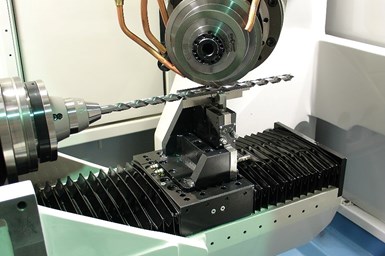
Typical deep-hole drilling processes include gundrilling, BTA drilling and carbide twist drills. Photo Credit: ANCA CNC Machines
Understanding the deep-hole drilling process and being aware of common problems turns a complex operation into a productive and profitable one. Deep-hole drilling produces holes in metal at high depth-to-diameter ratios on CNC machines. The length-to-diameter ratio is less than five times the diameter for normal drilling processes. The process is called deep-hole drilling if the length-to-diameter ratio goes beyond five.
Deep-hole drilling is effective in diameters ranging from 1–200 millimeters (0.04–8.00 inches). It requires special drills with through-coolant holes that deliver high-pressure coolant to evacuate chips cleanly and achieve required hole tolerances and surface finish.
Featured Content
Process Review
Some standard deep-hole drilling processes include gundrilling, BTA drilling (boring and trepanning association) and conventional carbide twist drills, each offering benefits based on hole diameter and tolerances.
- BTA drilling is an effective method of drilling deep holes, as it is cleaner, reliable and capable of achieving larger diameters at higher feed rates. BTA drilling is effective in holes from 20–200 millimeters (0.80–8.00 inches), a more extensive size range than gundrilling and carbide twist drills.
- Gundrilling was originally developed to drill out gun barrels and is commonly used for drilling smaller diameter deep holes. The depth-to-diameter ratio can be even greater than 300:1. The critical feature of gundrilling is that the bits are self-centering, which enables such deep, accurate holes.
- Carbide twist drills with through-coolant holes are also commonly used in several deep-hole drilling applications. The challenge is to manufacture and regrind these drills with minimal runout, which requires an additional axis on machines to support the flute grinding process.
One of the most significant challenges of deep-hole drilling is maintaining control of runout, which increases with cutting tool length.
Three Ways to Conquer Deep-Hole Drilling Challenges
1. Through coolant or internal coolant. Coolant can improve chip evacuation while cooling the cutting edge. Coolant is flushed down to the bottom of the hole, pushing the chips back up toward the top. Software is available that helps design and verify the coolant holes at the design stage, avoiding coolant holes breakage into flutes and eliminating scrap.
2. Hole straightness. The “margin or radial land” is the portion of the drill that contacts the hole. A single-margin drill (one margin per flute) is preferred in long-chipping materials. This is because single-margin drills provide additional clearance in the longer chipping materials. In contrast, a double-margin drill (two margins per flute) provides excellent hole straightness compared with a single-margin drill.
Although not as common, double-margin drills with a floating second margin are also available where a compromise can be made on hole straightness and chip evacuation, so more margins add accuracy while maintaining a higher surface finish but restrict the amount of clearance for chip evacuation.
3. Tool runout control. One of the most significant challenges of deep-hole drilling is maintaining control of runout, which increases with cutting tool length. Consider a more accurate method of toolholding that can deliver minimal runout and longer cutting tool life that includes a high-precision collet adapter and tool support system.
RELATED CONTENT
-
How to Choose the Right Tool Coating for Your Machining Application
Selection criteria and common coating attributes for PVD, CVD and other common coatings.
-
Three Ways to Accurately Machine Hardened Mold Materials
Three cutting tool design considerations to improve process reliability and cost efficiency when deep-hole drilling molds.
-
Hot Runners and Valve Gate Systems: A Moldmaking Team
Valve gates provide several advantages when using hot runners, including better appearance, safety and an overall better product. There are several types of valve gates, and it is important to choose the right one for your project.













